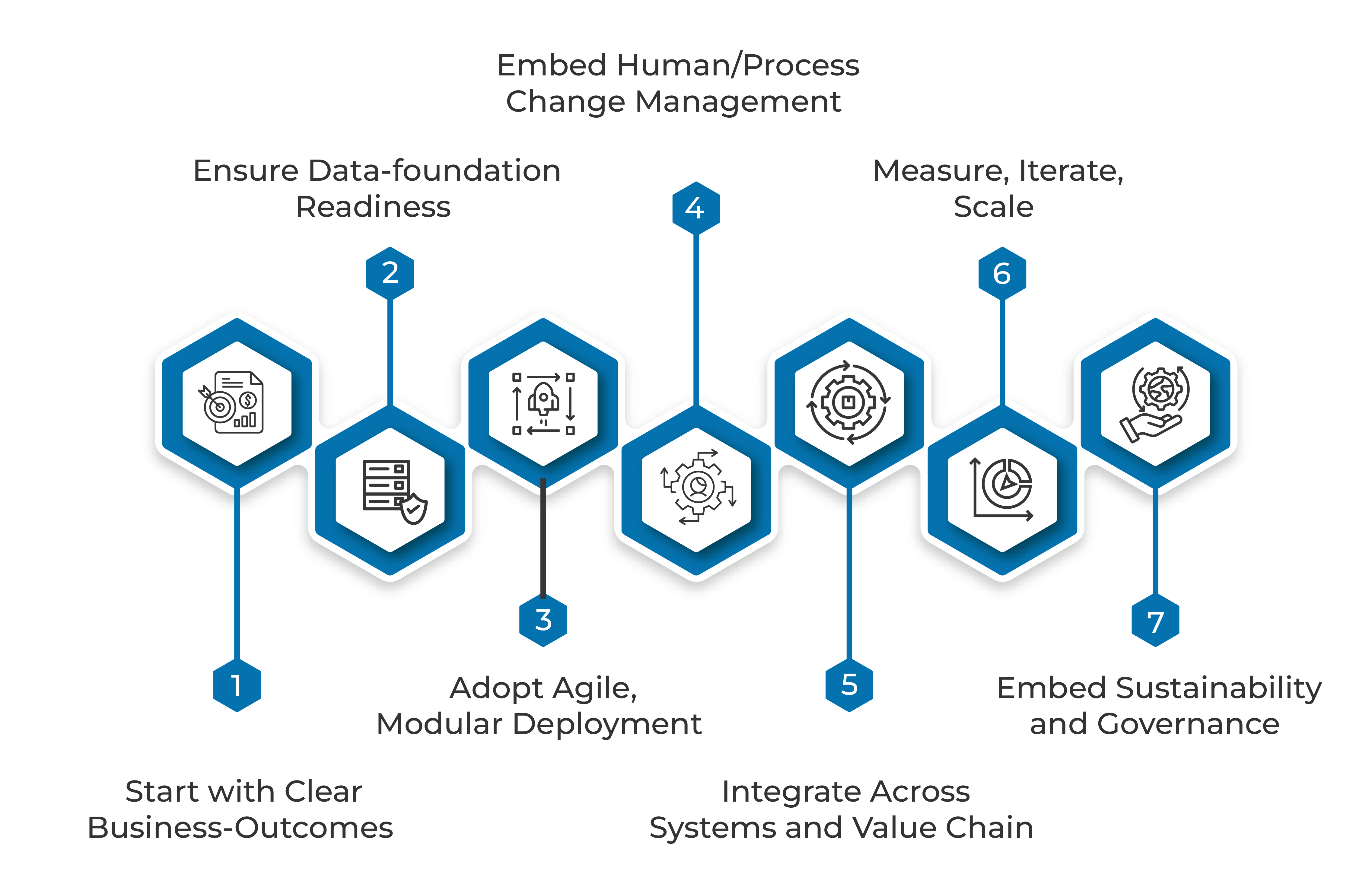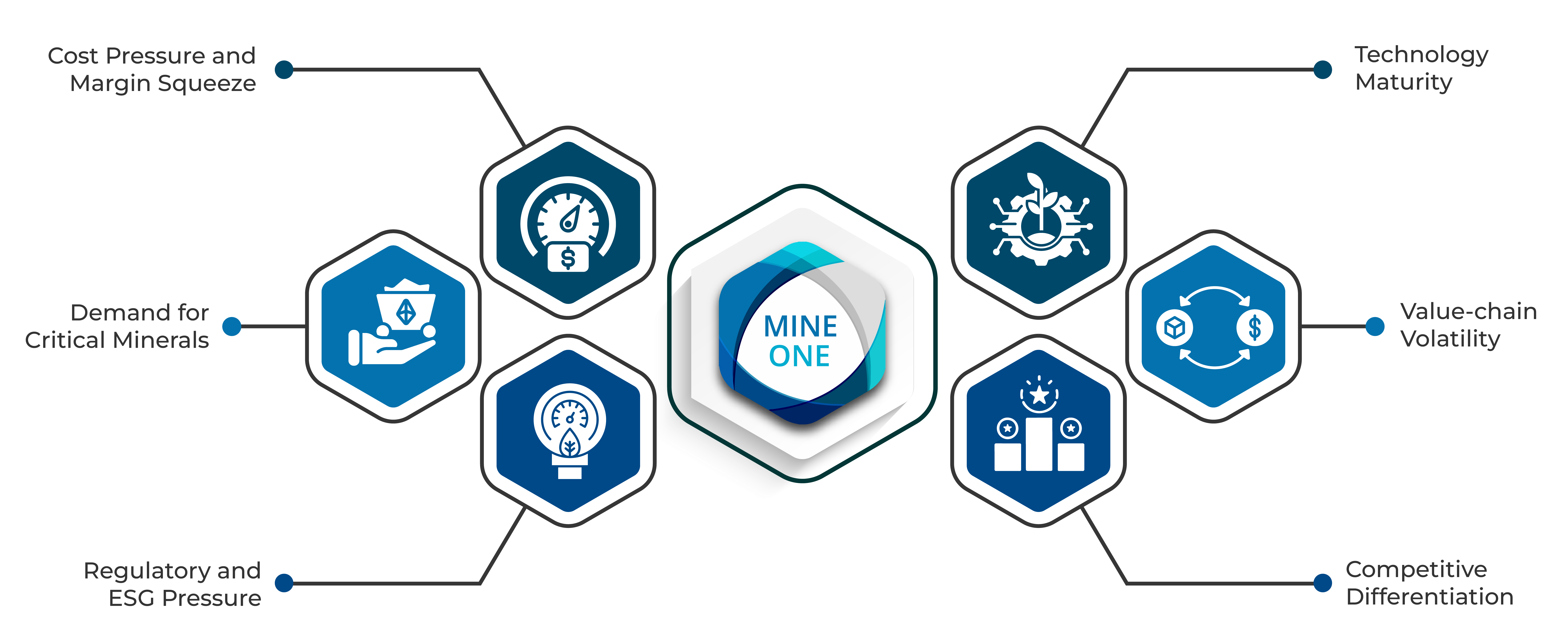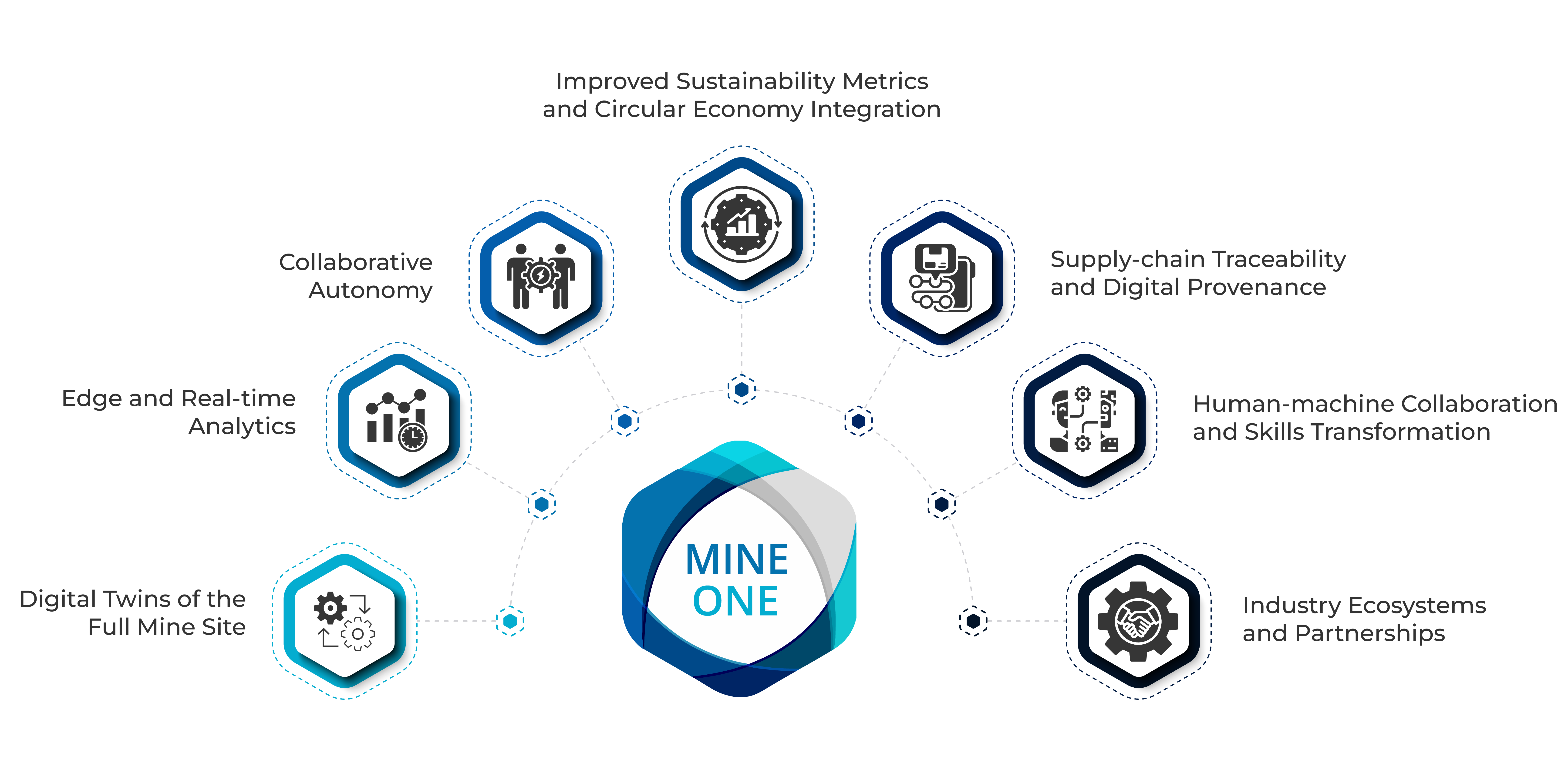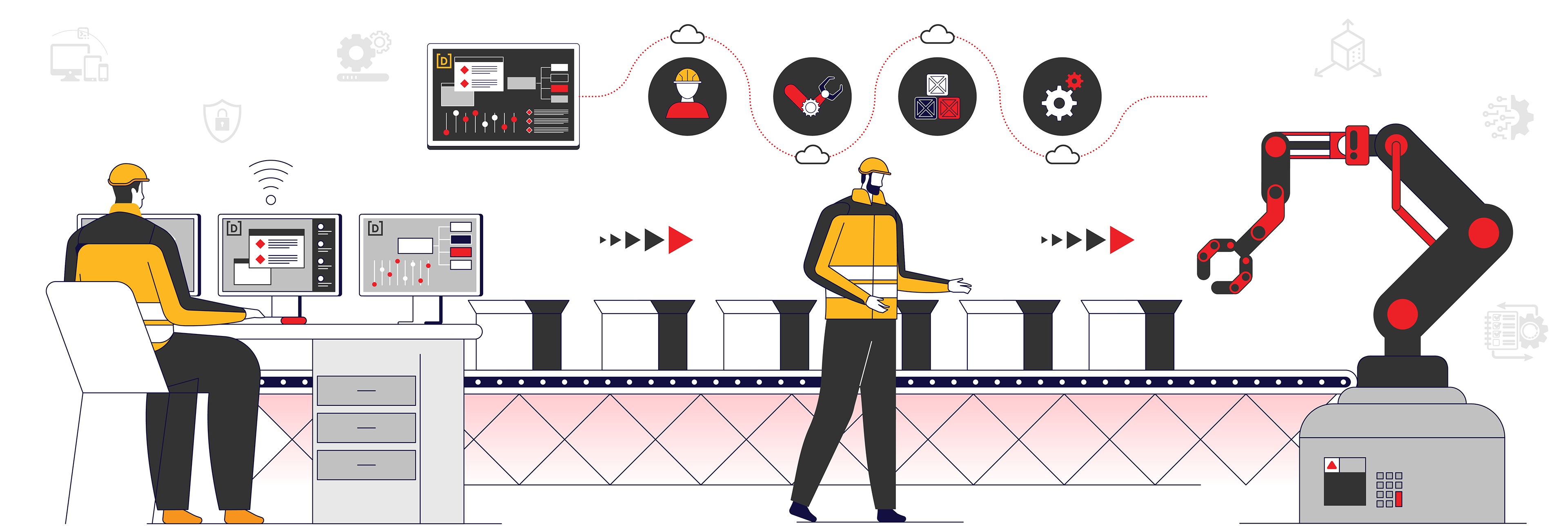
 Blog
Blog The Future of Mining Digitalisation: How Predictive, Prescriptive, Autonomous, and Sustainable Technologies are Redefining the Pit-to-Port Value Chain
The Future of Mining Digitalisation: How Predictive, Prescriptive, Autonomous, and Sustainable Technologies are Redefining the Pit-to-Port Value ChainThe Future of Mining Digitalisation: How Predictive, Prescriptive, Autonomous, and Sustainable Technologies are Redefining the Pit-to-Port Value Chain
Chitradip Pramanik
•
November 14, 2025
In this blog we explore the future of mining digitalisation through four inter-linked themes: Predictive, Prescriptive, Autonomous, and Sustainable. We’ll show how a modern mining digitalisation suite must span the entire value chain, and how MineOne™, powered by Devum™ is uniquely positioned to deliver this future with deep customisation, rapid deployment, and meaningful operations control.
The Digital Imperative for Mining
Mining is no longer simply about moving rock; it’s about orchestrating complex flows of material, assets, people, energy, and data across remote and hazardous geographies. According to a recent white-paper by Infosys, mining companies are increasingly embracing Industry 4.0 technologies – IoT, applied AI, digital twins, cloud/edge platforms to accelerate value creation across site and business management functions. [1]
Other research indicates that new technologies, sensors, machine-learning, autonomous vehicles, advanced analytics offer 5-15 % improvement in EBITDA when applied holistically and executed at scale.
For mining companies, the stakes are high:
- Asset utilisation must rise (so equipment is more productive, less idle).
- Safety and environmental performance must improve (and social license to operate must be maintained).
- Throughput, recovery and cost per tonne must be optimised.
- The ability to adapt quickly to market swings, ore variability, logistics disruptions is critical.
In short: digitalisation is not optional. The challenge is how to do it in a way that is integrated, flexible, and scalable across the pit-to-port value chain.
Four Dimensions of Future Mining Digitalisation
Let’s frame the future in four dimensions: Predictive, Prescriptive, Autonomous, and Sustainable. Each builds on the one before, and together they form the backbone of the next-generation digital mine.
1. Predictive
Predictive digitalisation is first about seeing ahead. Rather than reacting to failures, delays or cost overruns, predictive systems use data (from sensors, telemetry, process logs, geospatial systems) to forecast what will happen, and thus allow proactive response.
For example: IoT sensors on haul trucks, shovels or crushers feed condition-monitoring systems; machine-learning models detect anomalies or impending component failures; in processing, data from grind, reagent, throughput streams inform recovery models. Research shows that predictive maintenance and predictive planning are key enablers in mining 4.0.
Benefits of the predictive dimension include:
- Reduced unplanned downtime (because failures are caught earlier)
- Longer asset life and lower maintenance cost
- More stable throughput because bottlenecks are foreseen
- Better visibility for operations and management
Yet predictive alone is not enough because foresight must turn into action. That brings us to prescriptive.
2. Prescriptive
Prescriptive digitalisation is about going beyond prediction to recommending or automating the best course of action. If predictive systems tell you what will happen, prescriptive systems tell you what you should do (and sometimes automatically act) to optimise outcomes.
In mining, prescriptive analytics might include:
- Suggesting optimal shovel-truck dispatch schedules in real-time based on truck availability, ore grade, haul distance, crusher feed bias.
- Recommending sequence changes in ore extraction based on grade forecasting, logistics constraints, labour schedules.
- Adjusting processing plant parameters dynamically to maximise recovery given feed variability and reagent cost.
Whitepapers show that applied AI and prescriptive analytics are gaining importance in mining because they elevate decision-making from “what happened?” (descriptive) to “what should we do?” and “what if…” scenario modelling.
For mine sites, a prescriptive system offers:
- More agile operations (the ability to pivot when conditions change)
- Better resource utilisation (people, machines, materials)
- Less cost and higher throughput via optimised decisions
- A tighter link between operational decisions and business results
Again: prescriptive alone is powerful but the frontier is when these systems become autonomous.

3. Autonomous
Autonomous digitalisation is where mining operations increasingly execute themselves – systems monitor, decide, and act with minimal human intervention (or assist human operators with decision-making). This doesn’t mean humans are removed; rather, humans shift focus to oversight, exceptions, strategy, leaving repetitive, time-critical tasks to machines and software.
Examples in mining include:
- Autonomous haul trucks, loaders and drills operating around the clock in open-pit mines, lowering fuel usage and improving safety.
- Drones surveying haul-roads, highwalls, tailings storage facilities and feeding geo-data into digital twins for real-time monitoring.
- Digital twins of the mine site and processing plant that simulate scenarios, trigger alerts, and feed into automated decision loops.
- Self-optimising processing plants where control loops, analytics and scheduling systems drive changes automatically in response to feed or market conditions.
The benefits of autonomy include:
- Higher productivity and asset availability (machines run longer, fewer manual delays)
- Improved safety (humans removed from hazardous zones)
- Lower operating cost (fewer errors, fewer reactive interventions)
- Consistent performance even in variable conditions
However, autonomy does not happen overnight. It needs strong foundations of connectivity, interoperability, data quality, and change management. This is where a flexible platform matters.
4. Sustainable
Sustainability is now inseparable from the mining digitalisation story. As miners face pressure to decarbonise, reduce water/energy use, manage tailings risk, and prove responsible supply-chains, digital tools become critical enablers of sustainable operations.
Digitalisation supports sustainability by:
- Monitoring and controlling energy consumption, emissions and waste streams in real-time.
- Enabling optimal haul-road routing and fleet dispatching to minimise fuel and emissions.
- Supporting circular economy practices, e.g., reuse of process water, tailings dry-stacking optimisation, and secondary material recovery.
- Enhancing traceability and transparency across the value chain (from ore extraction to port to customer) which supports ESG disclosures, responsible sourcing credentials and social licences.
- Enabling closed-loop feedback between operations, asset performance, environmental management and corporate sustainability frameworks.
In the future mine, digitalisation is not just about cost or throughput, it is about long-term viability, stakeholder trust and environmental stewardship.
Pit-to-Port: The Full Value-chain Digitalisation
To deliver the full transformation, mining digitalisation must span the entire value chain from exploration and the pit to processing, logistics, port and supply to market. Let’s map how the predictive–prescriptive–autonomous–sustainable paradigm applies across this chain, and why a flexible, customised platform is critical.
Exploration and Mine Planning
- Geo-spatial data, drilling logs, core samples, remote sensing feed into digital twins of the orebody. This enables predictive models of grade distribution, ore variability and resource risk.
- Prescriptive analytics optimise drilling programmes, modelling scenarios of extraction, haulage, waste/ore ratios, mine sequencing.
- Autonomous survey drones map the pit, highwalls and terrain with minimal human intervention.
- Sustainability overlay: minimise over-dig, optimise land-use, reduce water/energy footprint of exploration.
Mining (Pit/Underground)
- Predictive maintenance of fleets (haul trucks, drills, shovels) using sensor data, condition monitoring and anomaly detection.
- Prescriptive scheduling of equipment, blast planning (variable spacing / charge), dispatch optimisation for haulage.
- Autonomous vehicles and remote-operation centres execute drilling, loading, haulage with reduced human exposure and increased uptime.
- Sustainability dimension: minimised fuel/emissions (via optimised haulage), reduced waste through selective mining, improved safety and social license.
Processing and Beneficiation
- Predictive feed-quality models anticipate ore variability, enabling proactive adjustment of processing parameters (grinding, flotation, leaching) to maintain recovery and throughput.
- Prescriptive controls adjust reagent dosing, throughput rates, energy usage according to evolving feed conditions and market price signals.
- Autonomous control systems apply optimisation loops in real-time, maintain plant balance, reduce downtime.
- Sustainability overlay: energy-efficient processing, water-reduction strategies, tailings-management monitoring and traceability.
Logistics, Port and Supply Chain
- Predictive tools model material movement, port throughput constraints, shipping schedules, export/market demand trends.
- Prescriptive analytics optimise routing of ore/waste, rail/road/truck schedules, stacking/reclaiming at port, customer delivery logistics.
- Autonomous systems (e.g., container/stacker reclaimers, port conveyors, autonomous trucks) operate with minimal human oversight.
- Sustainability dimension: optimised logistics reduce emissions, improved traceability enhances supply-chain credibility, circular logistics (re-use of packaging, conveyors) become feasible.
Business Management, ESG and Enterprise Control
- Predictive dashboards show not just operational metrics (tonnes, recovery, cost) but emerging risks (geopolitical, supply-chain, regulatory).
- Prescriptive decision-support enables executives to run “what-if” scenarios, e.g., ore price drop, logistics disruption, regulatory change and plan accordingly.
- Autonomous digital twins link mine-site, processing, logistics and enterprise systems into a continuous optimisation loop.
- Sustainability becomes strategic: carbon-footprint dashboards, waste reduction KPIs, social-impact monitoring, circular-economy integration.
Why Customisation Matters – The MineOne™ + Devum™ Difference
In many mining digitalisation solutions, a one-size-fits-all approach dominates: standard off-the-shelf modules, rigid workflows, heavy integration-overhead, long implementation times. What the modern mine demands is flexibility, adaptability, rapid deployment. This is where MineOne™ (underpinned by Devum™) stands apart.
Customisable to Unique Operational Requirements
Every mine is different: ore type, geography, haul-distance, infrastructure, workforce, processing route, logistics constraints, regulatory regime. Thus, any digital solution needs to be tailored not only in screens and dashboards but in workflows, data-models, decision-logic, integration, UX.
MineOne™, built on Reactore's enterprise low-code application platform, Devum™, allows for this high degree of customisation:
- Rapid design and deployment of modules for fleet dispatch, processing control, logistics scheduling, ESG-monitoring, etc.
- Ability to configure workflows and decision-rules specific to each mine’s reality – meaning that two mines deploying, for example, MineOne™ Geotechnical and Hydrological Monitoring solutions may have significantly different set-ups, yet both derive the same underlying value of visibility and control.
- Adaptation over time: as the mine evolves (e.g., expansion, new orebody, processing upgrade, logistics change), the application evolves too, without heavy re-engineering.
AI-driven Intelligence Plus Business-logic
The Devum™ platform provides analytics building-blocks (data-ingest, model-training, dashboards, alerts) so that predictive and prescriptive capabilities can be embedded rapidly. The low-code architecture means business users, mining domain experts, process engineers can collaborate with IT to build and tailor logic, reducing dependency on lengthy code-write cycles.
This means: the digital solution is not just a “monitoring tool” but becomes part of the operational fabric – steering decisions, triggering actions, closing loops between operations and business.
End-to-end Pit-to-port Coverage
MineOne™ is designed for full value-chain coverage from mining operations, processing, logistics, port/export and enterprise dashboards. The modular architecture means each segment can be implemented independently yet integrated into the overall suite. Together, they provide visibility across the entire chain: what’s coming out of the pit, how it’s processed, how it moves, how it sells.
That full-chain transparency enables executives and operations teams to link what they produce (tonnes, grade, recoveries) with what they deliver (logistics, port, customer supply) and ultimately their business margins and sustainability outcomes.
Rapid Time-to-value
Because MineOne™ is built on Devum™, an enterprise low-code, AI-ready platform, mining companies can achieve faster implementation, frequent customisation requirements from policy or procedure optimisations, compared to monolithic, bespoke systems. Quicker time-to-value means that insights, control and payoff (cost reduction, productivity gains, sustainability improvements) arrive earlier.
A faster deployment is critical in the mining world where market cycles, cost pressures and regulatory change can shift quickly.
Empowering People – Visibility and Control
At its heart, MineOne™ is about empowering people, not replacing them. With customisable dashboards, alerts, decision-support tools, operations teams gain better visibility of what they’re producing (and why) and control over how they produce it. Engineers, process managers, mine planners, logistics controllers, ESG officers all gain operational-centric visibility wrapped in role-specific workflows.
In turn, this improved visibility and control reduce the reliance on manual spreadsheets, siloed systems, tribal knowledge. Decisions become data-driven, collaborative, agile.
Real-world Use-cases (illustrative)
While client names may be NDA’d, the following illustrative use-cases show how the predictive-prescriptive-autonomous-sustainable paradigm plays out when deployed via a flexible suite like MineOne™.
Use-case A: Predictive Maintenance and Fleet Optimisation
In a large open-pit coal mine, sensor data from haul trucks (engine hours, loads, idling time, fuel consumption, vibration) is ingested into a Devum™-powered predictive model. The model forecasts likely component failures 48-72 hours ahead of time. Operations teams receive alerts, schedule maintenance proactively, reduce unplanned downtime by 18%. Further, integrating haul-road geometry, load data and truck dispatch logic, a prescriptive module recommends optimal dispatch sequences, reducing fuel usage by ~12%. The autonomy module further automates idle-truck detection and triggers re-routing without operator intervention. Sustainability benefit: lower fuel consumption, lower emissions.
Use-case B: Traffic, Dispatch and Logistics Optimisation
At a state-owned iron-ore mine, manual dispatching and poor traffic coordination led to long truck queues, safety risks, and lost throughput. MineOne™ digitalised the entire logistics chain with RFID-enabled truck tracking, manless weighbridges, and an AI-driven dispatch engine that dynamically managed queues and stockyard allocation. Results: 160% rise in annual sales, 70% higher truck utilisation, and 50% faster turnaround times, with zero safety incidents and lower fuel use. Built on Devum™’s low-code development platform, MineOne™ was customised to the mine’s unique layout and ERP system, proving how adaptive digitalisation can drive real efficiency from pit to port. Sustainability gains included reduced fuel consumption and zero safety incidents in high-traffic zones.
Use-case C: Logistics and Export Chain Transparency
A mining company exporting ore across a remote region uses MineOne™ to integrate haul-truck dispatch, rail/road movement tracking, port stacking/ reclaiming and shipping ETA modelling. Predictive modelling flags likely shipping bottlenecks given weather, vessel availability and port constraints. Prescriptive analytics suggest re-routing, stacking strategy changes or pre-emptive scheduling shifts. Autonomous components include real-time trucking telemetry and event-triggered alerts. Sustainability dimension: improved load-factor, lower idle time for trucks/trains; supply-chain transparency supports traceability to the customer.
Use-case D: ESG and Sustainability Monitoring
The underground mining operations at a large copper mine implemented geotechnical monitoring, energy-use tracking, water-consumption analytics and emissions dashboards within MineOne™. Predictive models forecast energy spikes or tailings-dam risk given operational changes or weather events. Prescriptive modules trigger alternative routing, reagent changes, energy-use shifts, or alert stakeholders. Autonomous reporting generates real-time ESG dashboards for managers and external auditors. Result: improved sustainability KPIs, fewer regulatory alarms, stronger social license.
Why MineOne™ / Devum™ are Uniquely Positioned
Let’s summarise the differentiators that set MineOne™ (on Devum™) apart in the market:
Implementation Considerations and Best Practices
To successfully deploy a suite like MineOne™ and realise the predictive-prescriptive-autonomous-sustainable future, mining companies should consider the following best practices:
- Start with Clear Business-Outcomes
- Identify what you need: higher throughput, lower cost, improved recovery, lower energy/water use, improved safety.
- Map to value chain segments (mining, processing, logistics, ESG) and select pilot use-cases with measurable KPIs.
- Ensure Data-foundation Readiness
- Connectivity, IoT sensors, data-ingest, cloud/edge infrastructure, cyber-security. As the Infosys whitepaper says: enablers (cloud, IT/OT, connectivity) + IoT enablement + data utilisation form the basis of Mining 4.0.
- Ensure data-quality, proper tagging, time-alignment of system logs, integration with legacy systems.
- Adopt Agile, Modular Deployment
- Rather than big-bang “digital mine” rollout, deploy modular use-cases (e.g., fleet maintenance, ore-grade feed prediction). Scale gradually.
- Use Devum™’s low-code application platform to speed up build/test/deploy cycles.
- Embed Human/Process Change Management
- Digitalisation is as much about people and process as it is about technology. Train operators, supervisors and managers. Embed new roles (data-scientist, digital-ops manager).
- Manage change: ensure users trust the system, dashboards align with how they work, and decision-support is relevant.
- Integrate Across Systems and Value Chain
- Avoid silos. Mining operations benefits more when data flows across pit, plant, logistics and business functions.
- A suite like MineOne supports end-to-end integration and unified dashboards.
- Measure, Iterate, Scale
- Set baseline KPIs (uptime, cost per tonne, recovery, energy use, emissions).
- Use pilot results to refine models, dashboards, rules, and expand to other value-chain segments.
- Leverage Devum™’s low-code flexibility to iterate quickly.
- Embed Sustainability and Governance
- Include ESG metrics from day-one (energy, water, emissions, waste, social impact).
- Use transparency and traceability to support external reporting, supply-chain credentials, stakeholder trust.

The Business Case: Why Now?
There are multiple forces driving mining companies to act now:
- Cost Pressure and Margin Squeeze: As high-grade orebodies decline and operating costs rise, mining companies must find productivity gains. Digitalisation offers one of the highest leverage levers.
- Demand for Critical Minerals: Transition to green energy (EVs, renewables) is increasing demand for metals like copper, nickel, lithium — mines must deliver reliably and sustainably.
- Regulatory and ESG Pressure: Investors and regulators demand stronger sustainability performance, traceability, emissions transparency and social-license proof points.
- Technology Maturity: Technologies (IIoT, AI/ML, cloud/edge, autonomous vehicles) have matured; adoption in mining is accelerating. The path is clearer and use-cases validated.
- Value-chain Volatility: Supply chains are increasingly complex and exposed to disruptions (yielding the need for agility, visibility and digital resilience).
- Competitive Differentiation: Early adopters in mining digitalisation gain 5-15% EBITDA uplift according to research.
Thus, implementing a comprehensive digitalisation suite like MineOne™ is no longer optional, it’s imperative for competitiveness, sustainability and future-readiness.

Why Mining Companies Partnering with Reactore Make Sense
Mining companies considering a digitalisation partner should evaluate several criteria: domain expertise (mining), platform flexibility, ability to customise, rapid deployment, full value chain coverage, sustainability orientation, alignment with business outcomes.
Reactore’s MineOne™ (on Devum™) meets those criteria:
- Deep mining domain knowledge (Reactore focusses on mining and metals).
- Low-code, AI-enabled platform (Devum™) that allows rapid build/configure/extend.
- Customisation at each mine: acknowledging that no two mines are identical, thus avoiding rigid one-size-fits-all systems.
- End-to-end value-chain lens: not just fleet or processing, but from pit to port, logistics and business management.
- Sustainability built-in, enabling mines to monitor and manage ESG metrics alongside production KPIs.
- Faster time-to-value and future-proof architecture meaning mines can adapt as conditions evolve (new orebody, new processing plant, new logistics route).
In essence: when you want a digitalisation partner who understands that your site is unique, that you need actionable visibility and control, and that you want a platform to evolve with you – Reactore (MineOne™ + Devum™) offers a strategic advantage.
Looking Ahead – What Next in Mining Digitalisation
The future of mining digitalisation continues to evolve. Some key trends to watch:
- Digital Twins of the Full Mine Site: The ability to create high-fidelity digital mirrors of the mine, processing plant, logistics and port enabling scenario modelling, risk simulation and real-time optimisation.
- Edge and Real-time Analytics: With connectivity constraints in remote sites, edge-computing will become more important. Decision-making will increasingly happen at the edge, not just in the cloud. [2]
- Collaborative Autonomy: Autonomous systems will coordinate with human supervisors and other machines in a shared ecosystem, e.g., fleets, drones, conveyors, processing plants working in sync. [3]
- Improved Sustainability Metrics and Circular Economy Integration: Mining operations will increasingly adopt zero-waste, low-carbon, water-efficient practices, with the digital suite acting as the integrator of production and sustainability data.
- Supply-chain Traceability and Digital Provenance: From ore extraction to product delivery, traceability frameworks (some leveraging blockchain) will become standard. [4]
- Human-machine Collaboration and Skills Transformation: As digital-ops become more advanced, workforce skills will change – mining engineers, data-scientists, digital-ops managers will become part of the operation. Mining companies must invest in up-skilling.
- Industry Ecosystems and Partnerships: The mining digitalisation story will be driven by partnerships – mining companies, equipment OEMs, platform providers, AI/analytics vendors working together to deploy systems at scale.

Reactore’s platform orientation positions MineOne™ well to stay ahead of these trends because its modular, flexible architecture allows mines to adopt new modules, integrate new and existing legacy technologies, and evolve digital workflows over time (rather than being locked into a static system).
Conclusion
The mining industry is undergoing a radical digital transformation. The future mine is predictive, prescriptive, autonomous and sustainable. It delivers not just tonnes of ore, but operational agility, business transparency, environmental stewardship and stakeholder trust.
For mines to succeed with this future, they need a digital-solution that is more than a dashboard; they need a highly customisable, AI-driven, low-code suite that spans the full value chain, from pit to port. They need visibility and control, but also flexibility and scalability.
That is precisely what the MineOne™ suite (powered by Devum™) offers:
- A platform that adapts to your mine (rather than forcing you to adapt to it).
- A digital architecture built to deliver predictive insights, prescriptive actions, autonomous execution and sustainable outcomes.
- A partner in Reactore that understands mining operations, understands digital transformation, and delivers solutions aligned to business and sustainability imperatives.
In a world where mining companies must deliver more with less – more throughput, less cost; more safety, less risk; more sustainability, less waste – the time to act is now. Deploying a field-proven, flexible digitalisation suite is not a nice-to-have, it’s a strategic imperative.
If you would like to explore how MineOne™ can be configured for your site, or see a demo of Devum™, the enterprise low-code development (AI) platform in action, please continue the conversation here.
___________________
[1] Infosys Limited. Mining 4.0: A Roadmap for Digital Transformation. 2021, https://www.infosys.com/industries/mining/documents/roadmap-digital-transformation.pdf
[2] de la Fuente, Raúl, Luciano Radrigan, and Aníbal S. Morales. “Enhancing Predictive Maintenance in Mining Mobile Machinery through a Tiny ML-enabled Hierarchical Inference Network.” arXiv:2411.07168, 16 Nov. 2024, https://arxiv.org/abs/2411.07168
[3] Puche, Victor V., Kashish Verma, and Matteo Fumagalli. “Underground Multi-robot Systems at Work: A Revolution in Mining.” arXiv:2509.16267, 18 Sept. 2025, https://arxiv.org/abs/2509.16267
[4] Ellis, Dominic. “Top 10 Technologies and Strategies in Mining.”Mining Digital, 14 July 2022, https://miningdigital.com/top10/top-10-technologies-and-trends-in-mining
Related Blogs
Get in touch with one of our mining technology gurus and learn how Reactore can assist with digital transformation possibilities.
Our Al-powered low-code application platform is a cost-effective alternative to traditional software development options. Build your dream app today!










